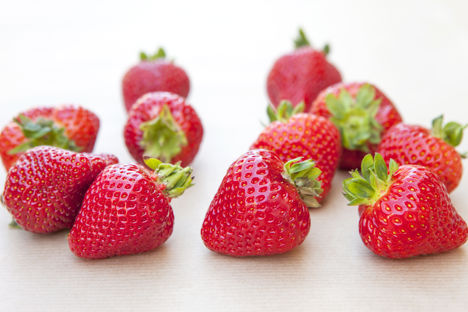
Ingredient focus: strawberry
With Wimbledon looming and the elusive British summertime peeking over the horizon, Sally Abé takes an in-depth look at this most beloved of fruits.
View more from this series:
Ingredient focusThe strawberry is generally seen as the quintessential English fruit, synonymous with tennis at Wimbledon where thirty tonnes of the sweet red berry are devoured every year, washed down with the mandatory Pimms and lemonade. Enjoyed since Roman times, there are many different varieties of strawberry hailing from many different countries. Historically, strawberries eaten in the UK were mostly the wild woodland variety fragaria vesca,however during the eighteenth century the variety fragoria x ananasa or ‘pineapple strawberry’ became popular. This variety was a crossbreed of two strawberries from the Americas and was so popular it became known as the garden strawberry and is now the basis of all strains of garden strawberry in the UK.
Such was the demand for strawberries in Britain, farmers were pushed to grow them all year round, trying to breed bigger and brighter fruits. Eventually taste became second to size, colour and shelf life, giving rise to the greenhouse-grown ‘cotton wool’ tasting imposters often cultivated en masse in Spain. Fortunately, in recent years there has been a resurgence in old varieties of strawberry and taste is once again driving things forward. Look for varieties such as Mara de Bois, Strawberry Alice and Cambridge for flavours that take you back to your childhood.
Strawberry season in the UK is June to August – anything available out of this time is likely grown in a greenhouse and imported from overseas. Strawberries ripen when the plant releases the hormone auxin, which causes the cell walls to degrade and soften. As they don’t ripen further once picked, it is best to buy local strawberries as this is a guarantee of freshness. Strawberries are high in immunity boosting antioxidants such as vitamin C, K and manganese and are also fat-free and relatively high in fibre.
Flavour profile
The sweet, jammy, caramel-like flavour of a perfectly ripe strawberry is the thing we all love about them, and the average strawberry is typically between six and nine percent sugar when ripe. These sweet roasted notes work with raspberry, cream cheese and dark chocolate.
There should also be a presence of acidity; not so much that the fruit becomes tart, but enough for it to bring out the citrus flavours. Herbs and spices such as cardamom, tarragon, lemon balm and lemon verbena all work well.
The strawberry is part of the rose family which means it has floral notes and also works with honey. The green notes in strawberry smell like cucumber and melon which link it to tomato, cucumber, black tea and cherries while the grassy, freshly cut grass smells make it compatible with avocado, hibiscus, chilli pepper and even bacon.
What goes with strawberries
Strawberries are most commonly eaten with cream or ice cream, or as part of a traditional Eton mess, and are a beautiful match to elderflowers which are also in season in June. Try Simon Hulstone’s Strawberry and elderflower dessert or for another floral match try Shaun Rankin’s Strawberry and lavender panna cotta with olive oil shortbread.
Matthew Tomkinson’s Assiette of strawberries with balsamic vinegar ice cream is a classic pairing but Graham Hornigold’s Strawberry and pea is a little more unusual and definitely worth the challenge. If you are feeling really brave why not give Alyn Williams’ Carpaccio of beef with pickled strawberries, wild spicy leaves and Ryvita.
Sumayya Usmani’s Strawberries, mango and cream perfectly links the fruity notes in strawberries and Paul Welburn’s Strawberry, douglas fir and basil complements the grassiness.
Did you know?
The strawberry is the only fruit that has its seeds on the outside, with roughly 200 seeds per fruit.
There is a museum in Belgium solely dedicated to strawberries.
The natural acids in strawberries can help to whiten teeth.


